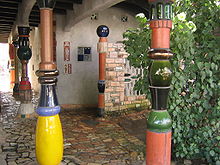TE PA KAINGA O REWA – REWA’S VILLAGE

Traditional plant used by the Maori
Filed under: http://schemas.google.com/blogger/2008/kind#post, Kerikeri, Maori, Northland, Rewa's_Village, TE_PA_KAINGA_O_REWA, Travels | Leave a comment »

Traditional plant used by the Maori
Filed under: http://schemas.google.com/blogger/2008/kind#post, Kerikeri, Maori, Northland, Rewa's_Village, TE_PA_KAINGA_O_REWA, Travels | Leave a comment »

The meeting point

The Lighthouse
Ninety-Mile Beach is officially a highway, but is really only suitable for 4WD vehicles and is safe to drive only at specific times of the tides. Rental companies won’t allow their cars on the sand, mostly for safety reasons. The easy way to drive along the beach is to catch a coach tour from Kaitaia. If you are short of time in Northland and staying in the Bay of Islands, coach tours and scenic flights up to Cape Reinga depart from Paihia daily.

Once a year in late February or early March, 90 Mile Beach hosts a five day fishing competition. Hundreds of anglers surf cast from the beach hoping to catch the biggest snapper, a delicious white-flesh fish found in New Zealand waters.
Filed under: Bay-of-islands, Cape_Rienga, http://schemas.google.com/blogger/2008/kind#post, Lighthouse, New Zealand, Northland, Pacific_Ocean, Tasman_Sea, Travels, Wild_horse | Tagged: Bay-of-islands, Cape reinga, faro, Kaitaia, Lighthouse, New Zealand, Ninety miles beach, Northland, Phare, wild horses | 1 Comment »
Filed under: Desert, http://schemas.google.com/blogger/2008/kind#post, New Zealand, Northland, sand_dune, Te_paki, Travels | 1 Comment »
Approximately at 20 minute drive from Kerikeri, visit the Glow Worm caves which are a further 5 kms. Yhen come back to Kerikeri via Paihia.
Kawakawa is a small town in the Northland Region of northern New Zealand.
The town is known as « Train town », because the Bay of Islands Vintage Railway runs down the middle of its main street on the way to Opua.
Kawakawa remains unique in having the railway running through its main street but the most known attraction in the city is the Hundertwasser toilets with its ceramic columns, garden roof and curving. Their colourful exuberance has put the Northland town of Kawakawa on the international tourist route. Designed and built by the Austrian artist Friedensreich Hundertwasser, internationally regarded architect and ecologist who, delighted by invitation, emerged from its reclusive lifestyle nearby from until 1975, to oversee the project. The Kawakawa toilets were Hundertwasser’s final creation and are seen as an important memorial to him after his death in 2000.

Entrance of the Hundertwasser toilet building
Filed under: ceramic_column, garden_roof, http://schemas.google.com/blogger/2008/kind#post, Hundertwasser_toilet, Kawakawa, Northland, Travels | Leave a comment »